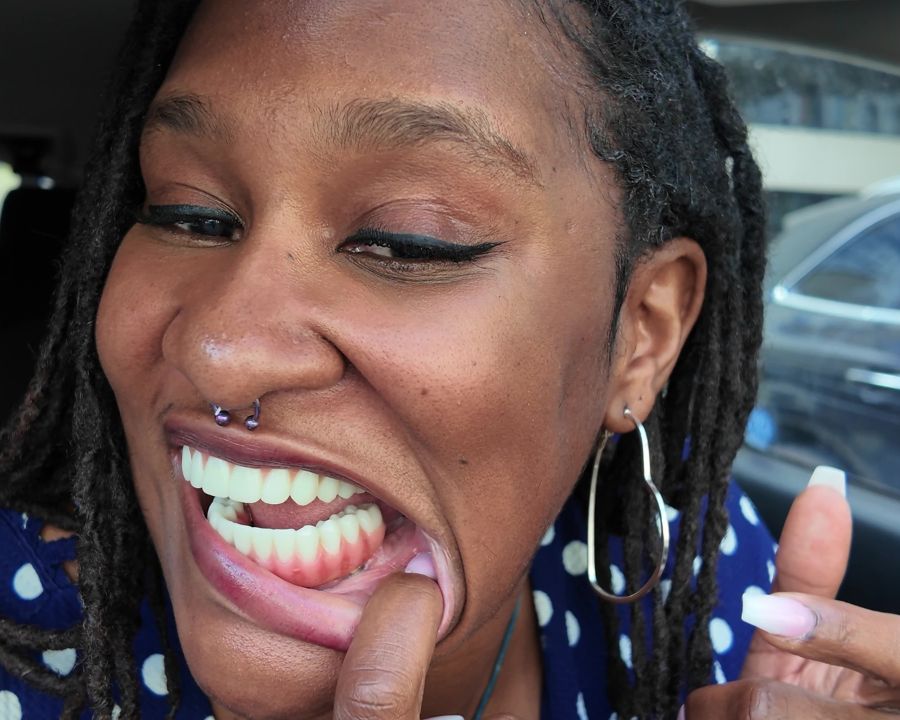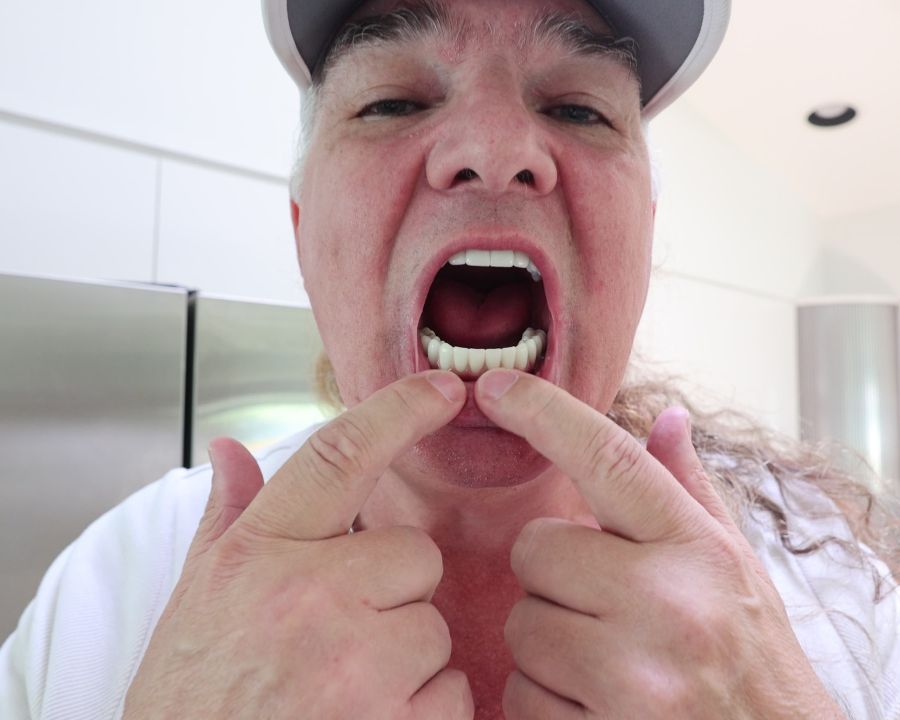If you’ve been considering full mouth dental implants, you may have heard about: a small gap forming between a patient’s new teeth and the gums after surgery.
It’s one of the most common questions patients ask after getting their new smile:
“Why is there a gap between my new teeth and my gums?”
It can be a bit surprising if you weren’t expecting it. But here’s the truth: That gap is normal, temporary, and planned for.
Let’s walk through why it happens, what it means for your healing, and how it’s fixed — with real details from a patient who went through it himself.
Why Do Gaps Under Dental Implant Arches Happen?
The gap that forms between your gums and your new set of implant-supported teeth is not a mistake. In fact, it’s built into the process — and for good reason.
When you first get your dental implants, your mouth is still in the early stages of healing. Your gums are likely to be swollen after the surgery and will need time to go back to normal.
Although this is very common, it doesn’t happen to everyone. It also isn’t unique to Nuvia’s permanent teeth in 24 hour process. It can happen with traditional “Teeth in a Day” methods as well.
A recent dental implant patient discussed what the past 6 months with his new dental implants has been like including having a gap and getting it fixed.
“When you get them installed, there’s a gap between the gum and the teeth, and it’s there purposely to allow your gums to heal. Now you whistle when you talk. You lisp. It’s kinda weird and uncomfortable, but you get used to it.”
While a gap might feel a bit awkward at first — like Ken said, maybe even causing a whistle or lisp — this healing window is temporary. It can also take time for your gums to settle. If a gap will appear, this is typically when it does.
See the Rest of Ken’s Story:
*Actual NUVIA patient(s) who may have been compensated for sharing their story. Not all those who come in for a consultation are eligible for this treatment. Results may vary in individual cases.
Not Everyone Will Have a Gap
Not everyone will develop a visible gap during the healing phase. Some people do, some don’t. It depends on how your tissue heals, the shape of your bone, and how your body responds post-surgery.
But for those who do experience it — rest assured, it doesn’t mean anything went wrong.
Ken went on to explain what happened during his follow-up appointment:
“When you go back on your four-month follow-up, they tighten it up and they put it up there and the whistle is gone. The lisp disappears, and it really feels much more comfortable.”
This is a normal part of the process. At the four-month appointment, your provider evaluates how the tissues have healed, and makes adjustments to close the gap (if there is one) — restoring the fit, the look, and the feel of your new smile.
How to Fix the Gap
Fixing the gap at the four-month follow up is a straightforward process. Here’s what typically happens:
First, you’ll have a quick CT scan to make sure that everything is healing as it should.
Then, if you don’t have a gap, your provider will make sure that your teeth are fitting tight and that you aren’t having any problems.
If there is a gap, your team will get some measurements and take the teeth to be adjusted. If your appointment was in the morning, you’ll return in the afternoon to have your teeth fitted without the gap.
At this point, the access holes in your teeth will be filled with a permanent material (instead of the silicone that is placed there during the first few healing weeks).
And simple as that, the gap is fixed, you have a brand new smile, and you’ll likely be given the all clear to eat whatever you’d like!
.jpg)
Should You Be Worried About the Gap?
In short: No. It’s not permanent and it doesn’t mean your implants are failing. It also doesn’t mean you chose the wrong provider, because it’s usually more about how your mouth heals than it is about your provider.
If you’re wondering if Nuvia’s 24 hour approach to dental implants is rushing the process and causing the gap… it’s not. The gap can happen with “Teeth in a Day”® methods as well. And because it’s a normal part of the process, the solution is already built in.
The permanent teeth in 24 hours process isn’t going to be the reason you have a gap. It’s going to leave you with your final set of teeth right from the beginning and plenty of support in case anything does come up.
There are clear benefits to having a strong set of zirconia teeth (as opposed to temporary, acrylic ones) during the healing time. While older methods use acrylic (denture material), zirconia is more durable, which can help prevent breakage and protects the implants from micromovement that could compromise healing.
What Happens If You Don’t Fix the Gap?
If you skipped your four-month appointment or delayed the adjustment when you had a gap, it might stay open. And over time, that could lead to:
- Food trapping under the bridge
- Speech changes (whistle or lisp)
- Less natural appearance
- Mild irritation or discomfort
But again — it’s easy to fix. And if you’re at a center like Nuvia, it’s already part of the plan. Just be sure to make it to your 4-month follow up!
What You Can Do to Prepare
If you’re considering full mouth dental implants — or you’ve already had them placed — here are a few tips to help you be prepared for any potential gaps:
1. Ask Questions Before Surgery
It’s okay to ask about the healing process and what to expect. A good provider will walk you through the plan, including when to come back for adjustments.
2. Know That Every Mouth Heals Differently
Some people develop a gap, others don’t. Although everyone heals differently, it’s important to know that you have a full team at Nuvia ready to support you during the process.
3. Keep Your Follow-Up Appointments
The four-month adjustment isn’t optional. It’s essential to making sure your final fit is as comfortable and functional as possible. If all is going well, it is also the appointment where you’ll likely be cleared to eat whatever you want.
4. Trust the Process
As Ken put it: “It turns out to be a good thing for a good reason.”
The gap is part of the healing process and just means your gums had the space they needed to heal and has no impact on your final result.
Take a look at some of these close ups of patient’s teeth after they’ve had a gap re-adjusted.




.jpg)










.jpg)
.jpg)



